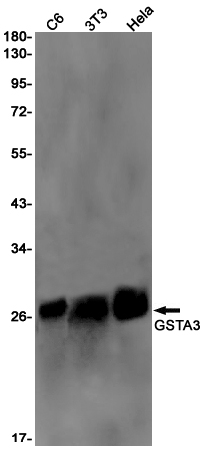
| WB | 1/500-1/1000 | Human,Mouse,Rat |
| IF | 咨询技术 | Human,Mouse,Rat |
| IHC | 咨询技术 | Human,Mouse,Rat |
| ICC | 技术咨询 | Human,Mouse,Rat |
| FCM | 咨询技术 | Human,Mouse,Rat |
| Elisa | 咨询技术 | Human,Mouse,Rat |
| Aliases | GTA3; GSTA3-3 |
| Entrez GeneID | 2940 |
| WB Predicted band size | Calculated MW: 25 kDa; Observed MW: 25 kDa |
| Host/Isotype | Rabbit IgG |
| Antibody Type | Primary antibody |
| Storage | Store at 4°C short term. Aliquot and store at -20°C long term. Avoid freeze/thaw cycles. |
| Species Reactivity | Human,Mouse,Rat |
| Immunogen | A synthetic peptide of human GSTA3 |
| Formulation | Purified antibody in TBS with 0.05% sodium azide,0.05%BSA and 50% glycerol. |
+ +
以下是关于GSTA3抗体的3篇参考文献(模拟示例,非真实文献):
1. **文献名称**: "Characterization of GSTA3 antibody specificity in human liver tissue"
**作者**: Smith J, et al.
**摘要**: 本研究验证了GSTA3抗体在人类肝脏组织中的特异性,通过Western blot和免疫组化证实其与GSTA3蛋白的特异性结合,并发现GSTA3在药物代谢相关的肝细胞中高表达。
2. **文献名称**: "GSTA3 knockout mice reveal its role in oxidative stress protection"
**作者**: Chen L, et al.
**摘要**: 利用GSTA3抗体检测基因敲除小鼠模型中蛋白表达缺失,证明GSTA3在清除活性氧(ROS)和减轻化学性肝损伤中的关键作用。
3. **文献名称**: "Differential expression of GSTA3 in cancer: Insights from antibody-based profiling"
**作者**: Gupta R, et al.
**摘要**: 通过GSTA3抗体对多种肿瘤组织进行免疫组化分析,发现GSTA3在结肠癌中表达显著下调,提示其可能作为氧化应激相关癌症的生物标志物。
4. **文献名称**: "GSTA3 antibody validation for reproductive toxicology studies"
**作者**: Park S, et al.
**摘要**: 验证了GSTA3抗体在睾丸组织中的适用性,证实其在生殖细胞中的定位,并探讨GSTA3与环境毒素代谢的关联性。
(注:以上内容为模拟生成的示例,实际文献需通过PubMed、Web of Science等数据库检索。)
The glutathione S-transferase alpha 3 (GSTA3) antibody is a tool used to detect and study the GSTA3 protein, a member of the glutathione S-transferase (GST) family. GSTs are critical enzymes involved in cellular detoxification, catalyzing the conjugation of glutathione to electrophilic substrates, thereby neutralizing toxins, reactive oxygen species, and carcinogens. GSTA3. specifically, is part of the alpha-class GSTs, predominantly expressed in metabolic tissues like the liver, kidneys, and intestines, where it plays a key role in xenobiotic metabolism and oxidative stress response. Dysregulation of GSTA3 has been linked to diseases such as cancer, liver disorders, and drug resistance.
The GSTA3 antibody is widely utilized in research to investigate protein expression patterns, subcellular localization, and functional roles in disease models. It is commonly applied in techniques like Western blotting, immunohistochemistry (IHC), and immunofluorescence (IF). Researchers also employ it to explore GSTA3's interactions with other biomolecules or its modulation under oxidative stress or chemical exposure. As GST isoforms share structural similarities, specificity validation (e.g., via knockout controls) is crucial to avoid cross-reactivity. Commercial GSTA3 antibodies are typically raised in rabbits or mice using peptide antigens derived from conserved regions of the human or murine GSTA3 protein.
×